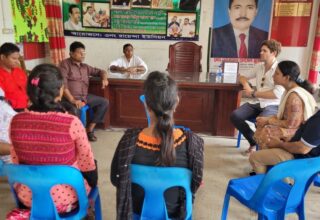(This article was originally published here)
As governments prepare to go to Paris in December to finalise the new Paris Agreement on Climate Change under the United Nations Framework Convention on Climate Change (UNFCCC) at its 21st Conference of Parties (COP21), there is an emerging consensus amongst all parties, including the developed countries, of the need to provide substantial funding to the poorest and most vulnerable developing countries. This consensus is aimed to support adaptation actions to meet the adverse impacts of human induced climate change that they are already facing.
However, there is still no agreement on how much and through which channels these funds should be delivered. Based on the previous experience of supporting adaptation finance, I have detailed below a description of the current landscape and then some ideas on how best to go forward.
Previous adaptation financing channels
There have been a number of modalities that have already been tried both under the UNFCCC as well as outside it, which provide valuable lessons.
1. LDC Fund (LDCF) was created as part of the Marrakech Accords agreed at COP7 in 2001, with voluntary contributions from developed countries, channeled through the Global Environment Facility (GEF). Initially, it provided all 49 LDCs with financing to develop the National Adaptation Programmes of Action (NAPAs) which were supposed to identify “urgent and immediate” adaptation actions in each country. The LDCF would then fund the implementation focusing on a project-by-project basis. All the LDCs completed their NAPAs some years ago, and most have received funding from the LDCF for their first priority adaptation projects. However, the fund at the moment does not have sufficient means to finance about 30 approved projects, costing a total of around $250 million. Since the replenishment of the fund by each developed country is done on an ad hoc basis, the fund cannot ensure a steady flow of money even when it has a pipeline of approved projects ready to be implemented.
2. Special Climate Change Fund (SCCF) was also created at the same time as the LDCF and also based on voluntary contributions from developed countries channeled through the GEF, to support adaptation in non-LDC developing countries. Over the years, a number of adaptation activities in developing countries have been financed from this fund.
3. The Adaptation Fund (AF) was set up after the Bali Action Plan at COP13 in Bali, Indonesia in 2010 and had a separate Adaptation Fund Board (AFB). It was initially based on the Adaptation Levy, which was a 2 percent charge levied on all transactions made under the Clean Development Mechanism (CDM). However, since the near collapse of the CDM market, the funding from the levy has almost dried up and it now also depends on voluntary contributions from developed countries. It pioneered the system of “Direct Access” of funding for developing countries, without having to go through intermediaries to receive funding.
4. Pilot Programme on Climate Resilience (PPCR) was set up under the World Bank in 2010 with a combination of loans and grants and focused on a set of ten selected highly vulnerable countries in Africa, Asia, South America and two regional projects in the Pacific and the Caribbean. These funds were channeled through the Regional Development Banks in each respective region.
5. Bilateral Development Funding Agencies. In addition to the major multilateral funds mentioned above, many developed countries also financed adaptation in self-selected developing countries through their respective bilateral development assistance agencies, often double counting Official Development Assistance (ODA) with Climate Adaptation Finance.
Green Climate Fund (GCF):
The GCF fund, initiated in 2013, is expected to be the main channel to deliver the promised $100 billion a year, starting from 2020 onwards to support all developing countries to tackle climate change both through mitigation as well as adaptation. It is also meant to mobilise considerable private sector investments as well as utilise contributions from developed country treasuries. The board has already had a number of meetings and have decided to allocate 50 percent of their funds to adaptation and also to prioritise the most vulnerable countries, such as LDCs and small island developing states (SIDS). It has received its first funding contributions from the developed countries and has identified a number of adaptation projects in a handful of LDCs.
How best to channel adaptation funding in future?
Firstly, it is important to note that while using public finance to leverage private finance to invest in tackling climate change is a reasonable strategy to pursue when it comes to mitigation actions in large developing countries such as China and India, it does not work when it comes to financing adaptation in the poorest and most vulnerable developing countries. Hence, developed countries will need to look to public finance for adaptation and cannot leave it to the market.
Secondly, the poorest and most vulnerable developing countries demand, and in my view deserve, to be provided with grants for adaptation financing and not loans, however concessional they may be. The recent statements and responses by the GCF Secretariat towards some LDCs submitting adaptation projects for financing has been to offer low interest loans instead of grants, which is quite troubling. The GCF Board needs to make a decision on rules for concessional finance clear, and do so quickly.
Thirdly, what is to be done about the existing adaptation funds, namely the LDCF, SCCF and AF? Should they be terminated, or allowed to continue (if so for how long?) or should they be absorbed into the GCF (if so how?). My personal view is that the LDCF in particular deserves to continue with a significant post-Paris replenishment by the developed countries in order to both support the immediate implementation of approved projects (which will require an immediate replenishment of at least $250 million). Also in the medium term (up to 2020), it should be guaranteed sufficient funds on a regular basis to finance the full pipeline of adaptation projects from their respective NAPAs (which will probably require around several billion dollars over the next five years or so). In addition, the COP could decide to develop the criteria for inclusion of countries to bring in other vulnerable countries (such as SIDS) within the purview of the LDCF. At the same time, some current LDCs would graduate out of the eligibility over time.
In the case of the AF, it may be best to think of ways in which it could become the Adaptation Window of the GCF, given its expertise in supporting adaptation in developing countries through Direct Access.
Fourthly, while prioritising the poorest and most vulnerable developing countries, the various funds also need to pay attention to allocating funds to the poorest and most vulnerable communities within each country. Better monitoring and reporting of funds to countries as well as within countries needs to be done. The latter being primarily the responsibility of the recipient countries themselves.
Finally, it would be best for developed countries to provide funding for adaptation in the poorest and most vulnerable developing countries through the established channels under the UNFCCC rather than through bilateral channels. While bilateral ODA should certainly be made “Climate Smart” and be used in synergy, rather than parallel, with climate finance on the ground, the double counting of ODA with obligations under the UNFCCC is at best confusing and at worst, morally questionable.
Written by: Dr Saleemul Huq, Director, International Centre for Climate Change and Development at the Independent University, Bangladesh









